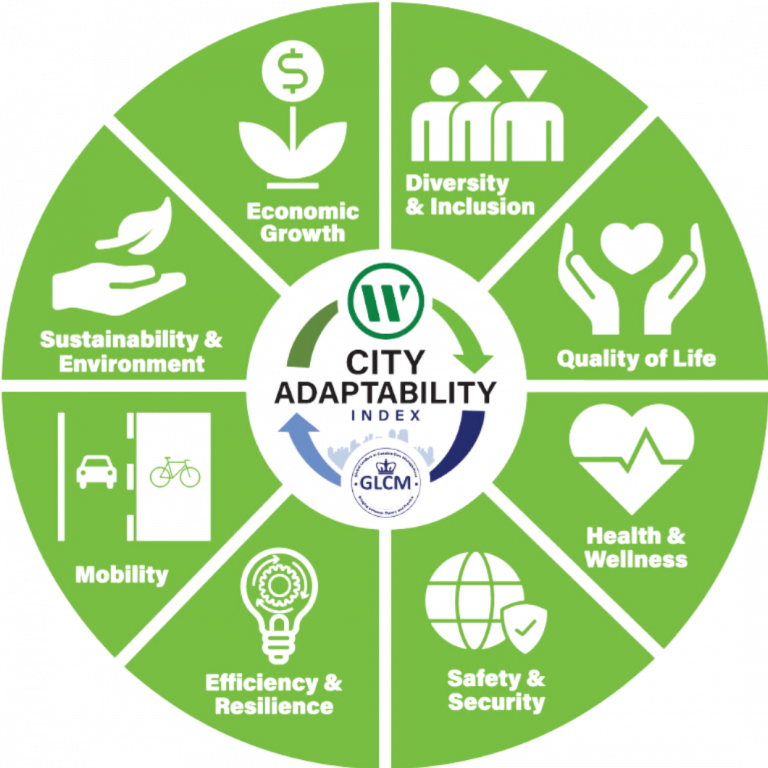
Empower Your City with Our Self-Assessment Tool
WGI proudly presents the City Adaptability Index™ self-assessment survey, meticulously crafted in partnership with Columbia University’s Global Leaders in Construction Management (GLCM). This tool is designed to gauge your city’s adaptability maturity, ensuring it’s poised to navigate the complexities of an ever-evolving landscape.

Assess Your City’s Adaptability
Benchmark your city against global standards. Take the assessment now.

With disruption moving from the exception to the norm,
it’s now more important than ever for cities to not just be resilient and sustainable, but to become adaptive to meet ever-increasing challenges and opportunities in the years ahead.
8 Pillars of Adaptability
The City Adaptability Index framework and self-assessment survey consists of 8 sections which correspond to 8 pillars of adaptability.
Each pillar represents a strategic goal of the city such as “Sustainability & Environment”. While each city may have differing priorities, these are universal strategic goals for cities no matter their size or location.

Eight pillars of adaptability (city strategic goals) in the City Adaptability Index
Digital + Physical Enablers

By implementing digital and physical enablers of adaptability within each pillar, to rapidly respond to change and disruption, or to seize new opportunities, the Adaptive City is able to continuously optimize the key performance indicators (KPIs) and metrics associated with each of these city strategic goals.
It can therefore meet more of its goals, for more of its stakeholders, for more of the time.
Adaptive Systems in Use Today
Physical Adaptive Systems
- Moveable Systems
Example: Thames Barrier, UK
- Modular Design + Construction
Example: Stadium 974, Dubai
- On-Demand Services
Example: Multi-functional street lights, Canada
- Intelligent Sensors
Example: Adaptive Traffic Control Systems, US
- Robotics + Drones
Example: Drone deliveries, Singapore
- AI/ML
Example: Welfare payments, fraud detection
- Blockchain + Smart Contacts
Example: Vehicle and land registries
- Intelligent Automation + RPA
Example: Finance, procurement, payroll
- Digital Twins
Example: DC Water in the District of Columbia
- Software Defined Networks
Example: Government data centers
Digital Adaptive Systems
Measure your city’s readiness for change and disruption.

Taking the Self-Assessment
The Index is a self-assessment tool for cities to benchmark their adaptability to continuous change and disruption. For a personalized copy of your results, or to prepare for a city-wide consultation, please contact us.
Time estimate for full survey: 8-10 minutes.
Economic Growth
- Funding Mechanisms
- Business Environment
- Economic Environment
Diversity + Inclusion
- Citizen Engagement
- Community Support
- Identity & Culture
Quality of Life
- Placemaking
- Education & Training
- Affordability
Health + Wellness
- Healthcare
- Housing
- Recreation
Safety + Security
- Personal Safety
- Cybersecurity
- Physical Security
Efficiency + Resiliency
- Efficiency of Operations
- Government Decision Making
- Resilience
Mobility
- Flexible Spaces
- Transportation Systems
- Personal Mobility
Sustainability + Environment
- Renewable Energy
- Pollution Control
- Hazard Management
- Step 1
Getting Started – Initiate and plan your City Adaptability Index™ assessment.
You can take the assessment as an individual citizen or city official. If taking as a city official, you can complete individually or as part of a city-wide consultation.
- Step 2
Collecting Data – Input and validate responses to assessment questions.
Our self-assessment survey takes just 8-10 minutes and asks questions on the maturity of programs and policies with respect to adaptability. The questions are grouped around the eight pillars to define four levels of maturity: limited, some, extensive, and purposeful implementation.
- Step 3
Analyzing Results + Taking Action
By implementing digital and physical enablers of adaptability within each pillar, to rapidly respond to change and disruption, or to seize new opportunities, your city will be able to continuously optimize the KPIs and metrics associated with each of your city’s strategic goals.

